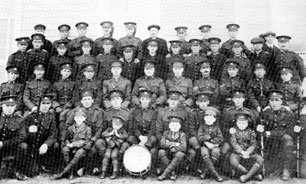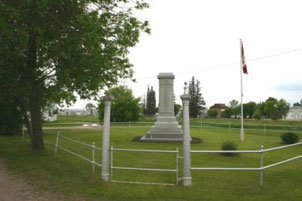|
IN
MANITOBA IN AUGUST 1914 the crops were ripe and the harvest well begun.
Interest was divided between garnering the grain and the news in our
daily newspapers. War was so far from our experience that we had no
conception of what its coming might mean. Day by day the newspapers
reported the alarming story of the German advance through Belgium. The
Hartney Star for August 13 stated there had been no decisive battles
yet. “There is a need for men, money and supplies to aid the
Motherland”. The August 29 issue of The Star reported “Terrible Battle
in Belgium; Britain loses 2,000 men; Namur occupied by Germans.”
In The Mere Living, Alice McDonald Parkinson provides additional
compelling observations of these terrible times, and provides us local
details that describe the terrible cost and the heavy burden borne by
its young men, and the community that waited and prayed for them.
“Early in September word reached Hartney that Chas Fee who had been
working in Winnipeg had joined the 79 Cameron Highlanders for overseas
duty. Thus the first Hartney boy to enlist was the son of one of
Hartney’s first settlers.
In October five men from the Hartney district enlisted: Russell
Butchart, George Lumsden, Herbert C. Batty, C. G. Webb (Manager of the
Union Bank at Hartney) and C.A. Anderson. Butchart, Anderson and
Lumsden served through the entire war. In December 1914 A.P.F. Singer
and Henry Strickland enlisted in the 45th Battalion, all three were
killed at the front before 1916 ended.
Interest in enlistment was strengthened by letters received from
Hartney boys already serving in France. The first such letter was from
Private Wilmer McArter to his mother and was printed in The Star. In it
he described the grain fields of France and told that he was in the
trenches and was determined to trust in the Almighty and keep his head
down.
A letter from Private Herbert Batty to Reverend C.A. Blay stated “I am
in the trenches up to my knees in mud. You would laugh if you could see
me now. I have a pair of leggings made of sandbags to keep the mud from
my legs. I look a tough bird, but I am happy as a lark, or a pig in a
mud puddle. The country is badly wrecked but although there are graves
in the field the farmers work their farms just behind the trenches as
if nothing was going on.”
A letter that appeared in The Star in September 1915 was from a soldier
who knew Robert Joslyn, the son of Reverend Joslyn. “Joslyn won the
D.C.M. at Ypres where as a runner he was carrying messages from command
headquarters to a forward trench after the telephone wires were down. I
saw him after he’d made the run two or three times. His face was white
for he knew he was facing death, but he was determined to do his duty.
I saw Joslyn last at an old house on April 25. I was sitting beside the
house trying to bind up my wound. He saw me and told me to wait while
he delivered a message and he helped me to the dressing station, but we
missed one another in the rush as there was heavy firing and the enemy
was advancing about two hundred yards en masse, and our boys were
holding strong to the trenches and any shelter to take up the frontage.
When I arrived back to the battalion from hospital ten days ago Joslyn
was missing. The boys said the last they saw of him was when
he jumped over the trench to make the charge on May 24. The boy next
him saw him fall and put up his hand and say ‘O Canada.’
Word reached Hartney that Private Singer was killed and Ypres in June
and that Private James McCann, Seargent William Cross, Private James
Watt and Private Henry Strickland had all died in the Somme fighting in
September.

Group portrait of the 222nd Batallion.
Robert Scharff had only reached enlistment age when he joined the Royal
Flying Corps in October 1917, the first Hartney boy to enter that
service. Scharff saw service on the Somme and at Arras before being
shot down and wounded over Douai. He was taken prisoner there by the
Germans. In a letter to his parents in December 1918 he told his story.
“You will remember I was shot down September 1st. I got 3 machine gun
bullets in my thigh and when I landed I ran into a sunken road. My
[Sopwith] Camel and I landed upside down so hard my right hip bone was
cracked. The Huns got hold of me and laid me in a pig pen. They took me
to a hospital in Douai where they pinched all my flying kit and left me
only a pair of breaches and my tunic. While there, the Hun doctors cut
a bullet out of my leg which had lodged just above the right knee. They
did it without an anaesthetic and to say the least it was painful. [As
a prisoner at Malheim-Ruhr in Germany] where I stayed until December
1919 I was fairly well treated. The food was poor, just one long
nightmare of horrible soup and black bread.
In April 1917 Private Howard Fry died of pneumonia in a hospital in
France and after the severe fighting at Vimy Ridge Seargent Harry
Brassine, Lance Corporal Kenneth Ross, Corporal Charles Walker and
Privates F.A. Peturson, Daniel McCuaig, and Robert Gallanger were
reported killed in action. Private Pettypiece and Private John Hardy
died at Passchendaele before 1917 closed.
The
World at War, 1914-1918
The horrible numbers that attended the destruction of World War I help
place the losses from Hartney into one of the great and terrible
stories of human history.
The total number of military and civilian casualties in World War I was
over 35 million. There were over 15 million deaths and 20 million
wounded ranking it among the deadliest conflicts in human history.

Soldiers in the muck on a battlefield.
The total number of deaths includes about 10 million military personnel
and about 7 million civilians. The Entente Powers (also known as the
Allies) lost about 6.0 million soldiers while the Central Powers lost
about 4.0 million.
Canadian total military deaths includes 53,000 killed or missing in
action and died of wounds. The Commonwealth War Graves Commission gives
a total of 64,976 military dead. The Canadian Virtual War Memorial
contains a registry of information about the graves and memorials of
Canadians and Newfoundlanders who served valiantly and gave their lives
for their country. The losses for Newfoundland are listed separately on
this table because it was not part of Canada at that time, but are
included in the CVWM registry. The 1922 War Office report listed 56,639
Army war dead. Civilian deaths were due to the Halifax Explosion.
About two-thirds of military deaths in World War I were in battle,
unlike the conflicts that took place in the 19th century when the
majority of deaths were due to disease. Improvements in medicine as
well as the increased lethality of military weaponry were both factors
in this development. Nevertheless disease, including the Spanish flu,
still caused about one third of total military deaths for all
belligerents.

The war memorial at Hartney, set in a pretty park with classical gate
columns.
|





